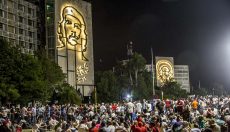By Jamil Oakford/ editor-in-chief

Patricia Richards/Special to The Collegian
A NE photography associate professor traveled to Cuba to document its people while they are in a state of mourning.
While Patricia Richards has traveled to Cuba numerous times before, this time she was met with a different scene than she remembered.
“Due to the nine days of mourning here in Cuba, there are no sales of alcohol and no music is being played anywhere,” Richards said by email from Havana. “Usually, it is very common to hear music playing everywhere, but at this time, it has been banned.”
During the time of mourning, Cuban television only replayed videos of Fidel Castro’s life and movies about the 1959 revolution that brought him to power as well as interviews with people close to him.
Having been to the famous Plaza de la Revolucion numerous times, Richards said the sight that met her on this trip was unlike anything she’d seen before.
“With the density of the crowd, it was surprising whenever I ran into (and often ran over) some who were seated,” she said.
But most were standing and friendly, Richards said.
“Although there was some sadness, most appeared to have gotten used to the idea that Fidel Castro was dead, and that this was his final rally,” she said.
No one was selling food, drinks or souvenirs, and Richards said pickpockets were nowhere to be found as well. It was purely a rally to say goodbye to Cuba’s leader for 47 years who died Nov. 25.
“Over the years, he has held many rallies in this square, and it was not uncommon for many who lived outside the city to be bused in to listen to his rhetoric,” she said. “So, indeed, this final rally in his honor lived up to those that had come before.”
On the taxi ride back to her hotel, Richards said occasional outbursts of “Viva la Revolution” and “Viva Fidel” could be heard.
“But it seemed as though it was time for the next part of Cuban history to begin,” she said. “I was delighted to be a part of it.”
The morning after, Richards said Fidel’s ashes, draped in the Cuban flag, were taken on a nationwide tour before his burial in Santiago de Cuba on the eastern side of the island Dec. 4.
And as for how Cubans feel about the future of U.S.-Cuban relations, Richards said the people are uncertain.
President-elect Donald Trump is gearing up to take office, and he’s been vocal about his thoughts on U.S.-Cuba relations on Twitter.
On Nov. 28, he tweeted, “If Cuba is unwilling to make a better deal for the Cuban people, the Cuban/American people and the U.S. as a whole, I will terminate the deal.”
“Some are fearful that negativity that Trump has exhibited up to this point will continue where Cuba is concerned,” Richards said.
For Cubans in Cuba, Castro was a symbol of communism and everything they believed. For those in exile, he symbolized an opposition to democracy.
Some Cubans see Castro’s death with different eyes and a newfound hope for a country they are exiled from.
“When I left, I left with the hope of coming back,” TR Spanish instructor Janet Rodriguez said. “With this regime change, maybe there is hope for my country.”
Rodriguez, who fled Cuba for the U.S. when she was 25, said life under Castro wasn’t easy. As a child, she remembered being bused to Havana’s Revolution Square to listen to one of Castro’s speeches.
“They didn’t ask for our parents’ opinion. They just took us on a bus at school to see him speak,” she said. “We were told when to clap, and we did so.”







